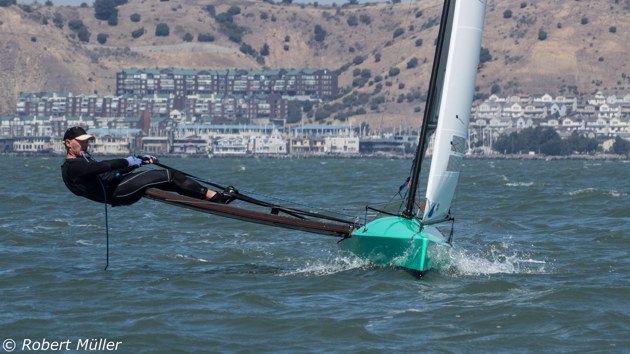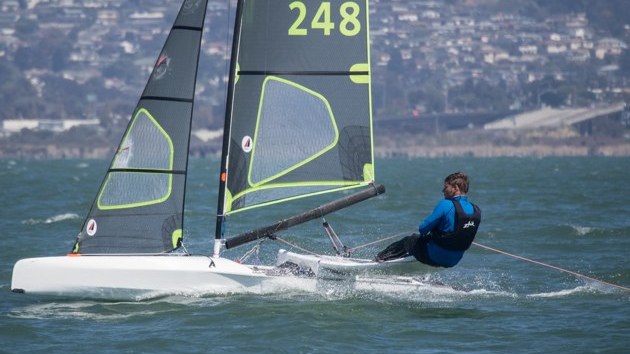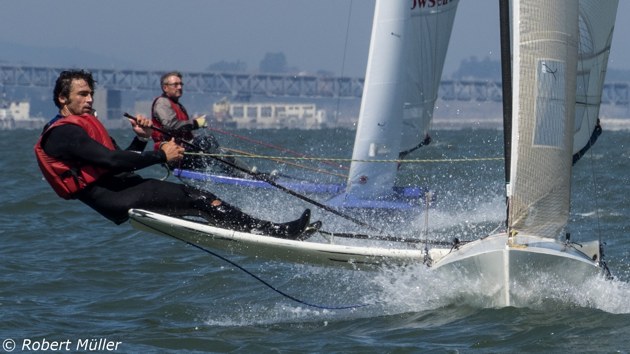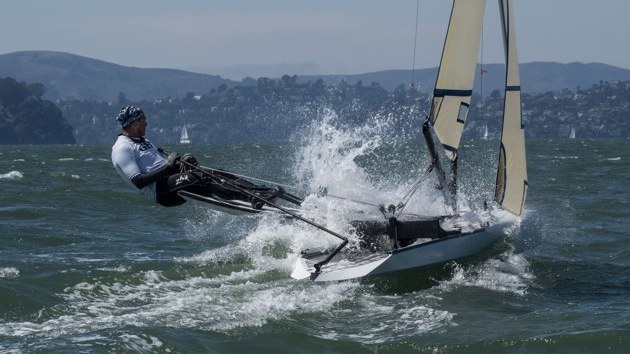IC Europa Cup 2013
Loch Lomond SC
Loch Lomond SC is the successor in kind and premises to the Clyde Canoe Club. With the class having long abandoned the Royal Canoe Club at Twickenham I suspect that makes LLSC the longest established sailing canoe racing organisation in the country.
Daily Reports from the Yachts and Yachting Website
- International Canoe Europa Cup day 1
- International Canoe Europa Cup day 2
- International Canoe Europa Cup day 3
- International Canoe Europa Cup day 4
- International Canoe Europa Cup day 5
Collections of photographs
More Reports and Information
For the first time for a few years ICs outnumbered ACs, by quite a margin in fact, and the majority of ICs were post 2005 rules boats in appreciable variety. The only significant designer missing was Chris Maas I think.. Even amongst the older boats there's a Slurp or two and a highly modified Nethercott, so there are only a handful of true One design ICs.
This was the first time for many years � certainly beyond the memory of all current active sailors - that such a varied choice of hull shapes wwere on offer.
Sponsored by Tunnocks (chocolate mallow tea cakes and wafer biscuits)and Glengoyne (whisky), the nutritional requirements of the competitors were well catered for!
Day One
We started � or rather didn't start � with an hour's postponement waiting for the wind. Forecast rain pretty much held off. Alistair Warren was kitted out in his raven black sailing kit and sent onto the course to look for wind, tide and sunshine. In true biblical style, he didn't return and so the 34 strong fleet ventured forth.and encountered a reasonable enough racing breeze, though not enough to take the boat away from the light airs settings.
Those of us who are not used to having our lakes surrounded by billion ton lumps of rock looked up wind trying to wonder what these hills and mountains were going to do to a light vaguely easterly breeze. The answers seemed to be "lots" and "nothing predictable". The first failure to predict occurred at about 90 seconds before the IC start, when a sudden and unexpected lull � first of the day - marooned various unwary competitors some way from the start line. The victims even included this reservoir sailor who really should know better. A complex race ensued, with much wind variation and as a result plenty of overtaking opportunities and consequent place changes. Colin Brown (IC) and Robin Wood (AC) led the respective fleets home.
Race 2 started in a bit more breeze � getting towards F3. A short first beat saw several overstanding the windward mark with their first tack and having to try and thread their way through on port! Turns were required and made! By lap two there was clearly something up on the weather front, and there were huge changes in wind direction. Soon there was lightning sparkling on the hills, and a black and white flag hoisted in the RC boat. Abandoned. All headed in at speed, great speed in fact (once they were upright anyway), and the later arrivals copped the full force of the squall and had very interesting lee shore arrivals�
Day Two
Well, for day two we had the long distance race. This started with a beat up the side of the island of Inchfad � which I'm told translates as Long Island and between Inchfad and Inchcruin, a passage which locals told us, with perhaps unnecessary relish, they call Hell's Gate due to the presence of a long reef which blocks about half the channel, with a narrow but well marked passage to starboard and a broader but less well marked passage to port. To windward of the passage was laid a windward mark which was rounded to port, followed by a spectacular high speed reach to the Island of Creinch, leaving that to starboard. This meant a beat round the back and another high speed reach back to the *same* windward mark, this time to be left to starboard. From there was a long downwind leg round the other side of Inchfad, emerging between it and Inchcailloch, with the course tightening up into a long too shy for AC kites reach to a leeward mark off the club. From there a second lap took us up through the gate of hell back to the windward mark, leaving it to port this time, and then running straight back down the far side of Inchfad, round the leeward mark and back up to the finish.
The three miles first beat started in a pleasant force 3, but Hell's Gate lived up to its name and, by the time the boats were reaching the first mark, a steady force 5 was blowing.
Loads of white horses and plenty of drama. It was no race for the faint hearted, and a couple of us fainthearts � or at least less healthy or with less well tried boats � bailed out at various stages. Alistair Warren led the fleet down the first reach, followed in hot pursuit by Gareth Caldwell, Robin Wood and Steve 'Twisted' Bowen.
Despite the strong winds, calm patches in the lee of some of the islands, and numerous wind shifts, the fleet coped admirably and positions remained fairly constant.
There were also some minor breakages, but nothing much worse than tiller extensions and string, with the possible exception of the AC that tripped over a rock at speed and whose daggerboard took a bit of extracting. Chris Hampe lost the clew of his mainsail, and was later to be seen learning how to rig a sewing machine�
Back to the race - there seemed to be a hell of a scrap going on for the lead, and as they came down to the leeward mark for the second time after some 20 plus miles of racing Alistair Warren and Robin Wood were just feet apart in clouds of spray. Technically they were in different races, and racing each other just for pride, and on the last beat the pride of place went to Alistair who just crossed the line ahead.
There were plenty of war stories on the beach: "Honest, the top of the Morrison's bow was level with the water and it still didn't pitchpole" was just one of them. Some happy boat mending in the afternoon for some, and then the day rounded off with that traditional Scottish entertainment, the visit to the distillery. In an act of extreme cunning, Phil Allen gave up his ticket to enable a fellow competitor to attend. The fact that those two were neck and neck in the racing results at the time did not go unnoticed! We gratefully acknowledge Glengoyne's sponsorship of the event, and enjoyed their products...
In amongst the sailing photos another image of the day was when Rob took his ex Robin Wood boat (280) out for an early evening sail. That boat has a pearl/metallic finish blue, and a break in the clouds had the low sun reflecting off the boat and off the wavelets around it for the most stunning visual effect on a boat I think I have ever seen�
Day Three.
The plan was to get three races in to get the event back on schedule. We launched in what seemed to be a lightish breeze, but which turned into a splendid F3 once we were well out on the lake and nearing the start. The wind shifted somewhat and dropped a bit after lap one, but the RC set up a well executed course change and mark shift. Thus the ACs continuing to do windward leewards and everyone had a reasonably square beat that had changed direction enough for anything we had learned about which side to go on lap one to become worthless again!
Colin Brown again showed a lean pair of heels to the rest of the IC fleet, with Gareth holding onto second place by half a boat length from Alistair. The AC fleet was again shown the way around the course by Robin Wood.
Race Four, the second of the day, was held in a lighter breeze which diminished as the race went on, spreading out the competitors wildly. Race 4 was held in a dying breeze, with numerous place changes due to the vagrancies of wind and direction. The last run was almost windless, and was extremely hard going, followed by a short beat to the line in which we must have averaged about 0.2 knots� In the ICs, Colin won followed by Alistair. Tony Robertshaw broke the dominance of Robin in the AC fleet.
At this point we were due for a third race, but although a bit of breeze filled in it was never very satisfactory in strength and direction. The RO's decision to throw up AP and C and retreat to the clubhouse for a late lunch was, I think, universally approved. After lunch we went out again and milled about for three quarters of an hour or so, but the wind never really co-operated, and in the end a halt was called. Amazingly enough the breeze didn't even fill in after racing was abandoned for the day.
Evening had a Scottish theme, complete with the piping in of the Haggis and then some country dancing. Scots know the dances (having been taught them at primary school), which came as a bit of a culture shock for the English and Welsh, let alone the German contingent, several of whom bravely joined in to this arcane folk ritual�
Day Four
Rain. Wet, wet wet. Weren't they a Scots band? The morning was damp, wet, miserable, and naff all wind. Even from the breakfast room of my B&B it seemed clear to the two competitors there that the AP was going to be the flag of the day. Supposedly, from conversation in the clubhouse, it was blowing 30 knots on the Isle of Arran 50 miles to the southwest. It wasn't at Loch Lomond. After about two and a half hours of a sodden red and white flag hanging limply from the flagpole a bit of breeze started to put in an appearance, and the drizzle subsided so the AP went down and it was time to get going. At this stage there was a distinctly foreboding feeling about the breeze: it had that feeling of a front coming in that was going to blow and blow stronger and stronger. There were one or two jitters on the beach and even the odd heavy weather sail coming out.
So we all sailed out, and it was a perfectly sane, but robust Force 3. Rather a decent canoe breeze, and we had a fair old blast about whilst the RC set a course for race Five. Two decent laps, albeit with the wind somewhat diminishing, and a very quiet last reach of a second triangle.
The wind filled in a bit again, and we started a second race. A decent first beat, a reasonable first leg of a triangle, and then the wind switched off pretty much completely. I suppose the leg must have taken a good half an hour, although a little bit of air came in at the end to get us back to the line and a welcome S flag.
Robin and Arne won races 5 and 6 in the AC fleet, and Alistair and Colin the IC fleet races.
That was it for the day. So what of the front that came in and then went to nothing? I chanced to see a meteorological synopsis map of the day. My goodness: complicated or what! There was a low centred west of Scotland and North of Ireland, with, at first sight, no less than three lines of front systems in it. On closer inspection two of those lines of fronts were actually comprised of two frontal systems which had merged, warm front changing into cold front, sometimes occluded... I have never ever seen anything as complex on a weather map. No wonder a front seemed to come in and then amount to nothing: there were more systems behind it confusing it all�
Day Five
Blown Off.
The sun came out to play... and so did the wind! True to form,the Scottish weather provided the contrasts we had become used to throughout the Championships. With 25 knots over the racecourse, with gusts of 28, the fleet were kept ashore by the OD.
Both Paul Hignett and Alistar Warren went out for a yacht and both demonstrated that it would need a signficant sized party of helpers allocated to each boat to get safely off the beach. Consequently, and even if the conditions out on the water had been anything other than extremely marginal, there was simply no way to get a fleet off the beach.
By 2 o'clock it was obvious that the wind had increased. with a forecast to increase even more, the last three races were abandoned.
Congratulations to Colin Brown and Robin Wood, IC and AC champions respectively. The fleet would like to thank everyone at Loch Lomond Sailing Club who made the event a success,with a special mention to Fergus Duncanson (OD) and Crawford Mac Calman (commodore) for exceptionally well run races and organisation throughout the week.
Gareth Caldwell & Jim Champ


Ulrike_veerkamp.jpg)




Ulrike_veerkamp.jpg)

Ulrike_veerkamp.jpg)
Ulrike_veerkamp.jpg)
Ulrike_veerkamp.jpg)



Ulrike_veerkamp.jpg)